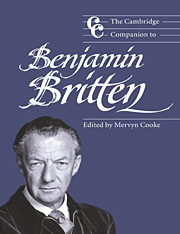15 - Britten and the world of the child
from Part four - The composer in the community
Published online by Cambridge University Press: 28 September 2011
Summary
Robin Holloway has commented that there exists a ‘two-sidedness’ in Britten's ‘primeval’ harmonic language:
Britten's ‘new start’ [as opposed to the romantic ones of Beethoven, Schubert, Mahler by way of Wagner's Rheingold Prelude and Bruckner] is quite different from such conscious primevalization; it is rather the natural extension of tendencies implicit in his brilliantly wayward mastery of traditional harmony, which, when pressed, can run quite counter to it though still alongside [My italics]
One possible key to this essential stylistic dichotomy may be summarized as the simultaneous co-existence of progress and regress in his musical aesthetic. These apparently conflicting states were bound together by Britten throughout his creative life by an artistic quest for Beauty. This may be viewed as a highly personal interpretation of an essentially Platonic position: Plato's pre-Christian philosophy revolved around the concept of god-like invisible archetypes (‘Forms’) standing outside creation yet partially revealed through the contemplation of it. Thus, classically, in the association of Platonic epistemology with Greek homoeroticism the ‘Form’ of Beauty could be most perfectly perceived by encountering it through the beauty of a young boy. For one to whom the beauty of childhood meant so much, the appropriation of this philosophy would be virtually intuitive. Britten's most overt public revelation of the personal significance of this theme is explored in his final opera, Death in Venice.
- Type
- Chapter
- Information
- The Cambridge Companion to Benjamin Britten , pp. 277 - 291Publisher: Cambridge University PressPrint publication year: 1999
- 1
- Cited by



